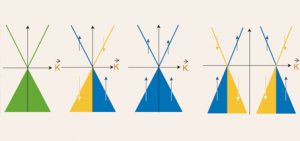Spintronic devices use a quantum property known as ‘spin’, in addition to the electronic ‘charge‘ used in conventional electronics.
This vastly increases the computing power of a device, via a deceptively simple piece of maths…
A single ‘bit’ of a conventional device can take two states: represented as 0 and 1. The computing power of conventional electronics thus increases by 2 to the power of the number of bits (2n). One bit (21) = two states, two bits (22) = four states, three bits (23) = eight states. This increases very rapidly so that only 64 bits (264) gives two-billion-billion states, and a thousand bits (21000) = 10300 states (ie, 1 followed by 300 zeroes, many-many times more than the number of atoms in the universe).
In comparison, a single ‘bit’ of a spintronic device has four states: 0-spin up, 0-spin down, 1-spin up, 1-spin down. Its power thus increases by four to the power of the number of bits (4n). One bit (41) = four states, two bits (42) = 16 states, three bits (43) = 64 states. In a spintronic device, a thousand bits would give 10600 states.



